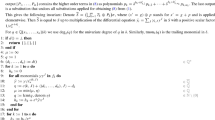Abstract
Several biological and biochemical mechanisms can be modeled with relativelysimp le sets of differential algebraic equations (DAE). The numerical solution to these differential equations provide the main investigative tool for biologists and biochemists. However, the set of numerical traces of verycomp lex systems become unwieldyt o wade through when several variables are involved. To address this problem, we propose a novel wayto querylarge sets of numerical traces bycom bining in a new wayw ell known tools from numerical analysis, temporal logic and verification, and visualization.
In this paper we describe XS-systems: computational models whose aim is to provide the users of S-systems with the extra tool of an automaton modeling the temporal evolution of complex biochemical reactions. The automaton construction is described starting from both numerical and analytic solutions of the differential equations involved, and parameter determination and tuning are also considered. A temporal logic language for expressing and verifying properties of XS-systems is introduced and a prototype implementation is presented.
The work reported in this paper was supported bygran ts from NSF’s Qubic program, DARPA, HHMI biomedical support research grant, the US department of Energy, the US air force, National Institutes of Health and New York State Office of Science, Technology & Academic Research.
Access this chapter
Tax calculation will be finalised at checkout
Purchases are for personal use only
Preview
Unable to display preview. Download preview PDF.
Similar content being viewed by others
References
R. Alur, C. Belta, F. Ivančić, V. Kumar, M. Mintz, G. Pappas, H. Rubin, and J. Schug. Hybrid modeling and simulation of biological systems. In Proc. of the Fourth International Workshop on Hybrid Systems: Computation and Control, LNCS 2034, pages 19–32, Berlin, 2001. Springer-Verlag. 435
R. Alur, C. Courcoubetis, N. Halbwachs, T.A. Henzinger, P.-H. Ho, X. Nicollin, A. Olivero, J. Sifakis, and S. Yovine. The Algorithmic Analysis of Hybrid Systems. Theoretical Computer Science, 138:3–34, 1995. 432, 441
U. S. Bhalla and R. Iyengar. Emergent properties of networks of biological signaling pathways. SCIENCE, 283:381–387, 15 January1999. 435
R.W. Brockett. Dynamical systems and their associated automata. In U. Helmke, R. Mennicken, and J. Saurer, eds., Systems and Networks: Mathematical Theory and Applications—Proceedings of the 1993 MTNS, volume 77, pages 49–69, Berlin, 1994. Akademie-Verlag. 435, 441
A. Cornish-Bowden. Fundamentals of Enzyme Kinetics. Portland Press, London, second revised edition, 1999. 433
H. de-Jong, M. Page, C. Hernandez, and J. Geiselmann. Qualitative simulation of genetic regulatoryne tworks: methods and applications. In B. Nebel, ed., Proc. of the 17th Int. Joint Conf. on Art. Int., San Mateo, CA, 2001. Morgan Kaufmann. 434
M. Elowitz and S. Leibler. A synthetic oscillatory network of transcriptional regulators. Nature, 403:335–338, 2000. 434, 435, 440, 441
E.A. Emerson. Temporal and Modal Logic. In J. van Leeuwen, ed., Handbook of Theoretical Computer Science, volume B, chapter 16, pages 995–1072. MIT Press, 1990. 439
D. Endy and R. Brent. Modeling cellular behavior. Nature, 409(18):391–395, January 2001. 435
R. Hofestädt and U. Scholz. Information processing for the analysis of metabolic pathways and inborn errors. BioSystems, 47:91–102, 1998.
D.H. Irvine and M.A. Savageau. Efficient solution of nonlinear ordinary differential equations expressed in S-System canonical form. SIAM Journal on Numerical Analysis, 27(3):704–735, 1990. 434
B. Kuipers. Qualitative Reasoning. MIT Press, 1994. 435
B. E. Shapiro and E.D. Mjolsness. Developmental simulation with cellerator. In Proc. of the Second International Conference on Systems Biology (ICSB), Pasadena, CA, November 2001. 435
B. Shults and B. J. Kuipers. Proving properties of continuous systmes: qualitative simulation and temporal logic. Artificial Intelligence Journal, 92(1-2), 1997. 435
E.O. Voit. Canonical Nonlinear Modeling, S-system Approach to Understanding Complexity. Van Nostrand Reinhold, New York, 1991. 432, 433
E.O. Voit. Computational Analysis of Biochemical Systems A Practical Guide for Biochemists and Molecular Biologists. Cambridge University Press, 2000. 432, 433
Author information
Authors and Affiliations
Editor information
Editors and Affiliations
Rights and permissions
Copyright information
© 2002 Springer-Verlag Berlin Heidelberg
About this paper
Cite this paper
Antoniotti, M., Policriti, A., Ugel, N., Mishra, B. (2002). XS-systems: eXtended S-Systems and Algebraic Differential Automata for Modeling Cellular Behavior. In: Sahni, S., Prasanna, V.K., Shukla, U. (eds) High Performance Computing — HiPC 2002. HiPC 2002. Lecture Notes in Computer Science, vol 2552. Springer, Berlin, Heidelberg. https://doi.org/10.1007/3-540-36265-7_41
Download citation
DOI: https://doi.org/10.1007/3-540-36265-7_41
Published:
Publisher Name: Springer, Berlin, Heidelberg
Print ISBN: 978-3-540-00303-8
Online ISBN: 978-3-540-36265-4
eBook Packages: Springer Book Archive




